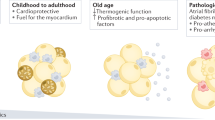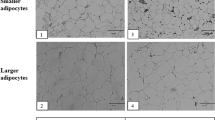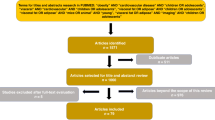Abstract
A growing amount of evidence suggests that regional fat distribution plays an important part in the development of an unfavorable metabolic and cardiovascular risk profile. Epicardial fat is a metabolically active organ that generates various bioactive molecules, which might significantly affect cardiac function. This small, visceral fat depot is now recognized as a rich source of free fatty acids and a number of bioactive molecules, such as adiponectin, resistin and inflammatory cytokines, which could affect the coronary artery response. The observed increases in concentrations of inflammatory factors in patients who have undergone coronary artery bypass grafting remain to be confirmed in healthy individuals. Furthermore, epicardial adipose mass might reflect intra-abdominal visceral fat. Therefore, we propose that echocardiographic assessment of this tissue could serve as a reliable marker of visceral adiposity. Epicardial adipose tissue is also clinically related to left ventricular mass and other features of the metabolic syndrome, such as concentrations of LDL cholesterol, fasting insulin and adiponectin, and arterial blood pressure. Echocardiographic assessment of epicardial fat could be a simple and practical tool for cardiovascular risk stratification in clinical practice and research. In this paper, we briefly review the rapidly emerging evidence pointing to a specific role of epicardial adipose tissue both as a cardiac risk marker and as a potentially active player in the development of cardiac pathology.
This is a preview of subscription content, access via your institution
Access options
Subscribe to this journal
Receive 12 print issues and online access
$209.00 per year
only $17.42 per issue
Buy this article
- Purchase on Springer Link
- Instant access to full article PDF
Prices may be subject to local taxes which are calculated during checkout




Similar content being viewed by others
References
Grundy SM et al. (2004) Definition of metabolic syndrome: report of the National Heart, Lung, and Blood Institute/American Heart Association Conference on scientific issues related to definition. Circulation 109: 433–438
Carr DB et al. (2004) Intra-abdominal fat is a major determinant of the National Cholesterol Education Program Adult Treatment Panel III criteria for the metabolic syndrome. Diabetes 53: 2087–2094
Kershaw EE et al. (2004) Adipose tissue as an endocrine organ. J Clin Endocrinol Metab 89: 2548–2556
Sharma AM (2002) Adipose tissue: a mediator of cardiovascular risk. Int J Obes Relat Metab Disord 26 (Suppl 4): S5–S7
Dusserre E et al. (2000). Differences in mRNA expression of the proteins secreted by the adipocytes in human subcutaneous and visceral adipose tissues. Biochim Biophys Acta 1500: 88–96
Wajchenberg BL (2000). Subcutaneous and visceral adipose tissue: their relation to the metabolic syndrome. Endocr Rev 2: 697–738
Sharma AM (2004) Mediastinal fat, insulin resistance, and hypertension. Hypertension 44: 117–118
Silver M and Silver M (2001) Examination of the heart and of cardiovascular specimens in surgical pathology. In Cardiovascular Pathology, edn 3, 1–29 (Ed Schoen F). Philadelphia: Churchill Livingstone
Marchington JM et al. (1989) Adipose tissue in the mammalian heart and pericardium: structure, foetal development and biochemical properties. Comp Biochem Physiol B 94: 225–232
Corradi D et al. (2004). The ventricular epicardial fat is related to the myocardial mass in normal, ischemic and hypertrophic hearts. Cardiovasc Pathol 13: 313–316
Olivetti G et al. (1995) Gender differences and aging: effects on the human heart. J Am Coll Cardiol 26: 1068–1079
Iacobellis G et al. (2003) Epicardial fat from echocardiography: a new method for visceral adipose tissue prediction. Obes Res 11: 304–310
Iacobellis G et al. (2003) Echocardiographic epicardial adipose tissue is related to anthropometric and clinical parameters of metabolic syndrome: a new indicator of cardiovascular risk. J Clin Endocrinol Metab 88: 5163–5168
Iacobellis G et al. (2003) Images in cardiology: massive epicardial adipose tissue indicating severe visceral obesity. Clin Cardiol 26: 237
Sironi AM et al. (2004) Visceral fat in hypertension: influence on insulin resistance and β-cell function. Hypertension 44: 127–133
Schejbal V (1989) Epicardial fatty tissue of the right ventricle morphology, morphometry and functional significance. Pneumologie 43: 490–499
Reiner L et al. (1955). Statistical analysis of the epicardial fat weight in human hearts. AMA Arch Pathol 60: 369–373
Reiner L et al. (1959). The weight of the human heart, I. Normal cases. AMA Arch Pathol 68: 58–73
Reiner LMA et al. (1961). The weight of the human heart, II. Hypertensive cases. Arch Pathol 71: 180–201
Reiner LMA et al. (1964). The weight of the human heart. III. Ischemic heart disease. Arch Pathol 77: 205–217
Shirani J et al. (1995). Quantitative measurement of normal and excessive (cor adiposum) subepicardial adipose tissue, its clinical significance, and its effect on electrocardiographic QRS voltage. Am J Cardiol 76: 414–418
Tansey DK et al. (2005) Fat in the right ventricle of the normal heart. Histopathology 46: 98–104
Iacobellis G et al. (2004). Relation between epicardial adipose tissue and left ventricular mass. Am J Cardiol 94: 1084–1087
Pond CM (1998) The Fats of Life. Cambridge: Cambridge University Press
Mattacks CA and Pond CM (1987) Site-specific and sex differences in the rates of fatty acid/triacylglycerol substrate cycling in adipose tissue and muscle of sedentary and exercised dwarf hamsters. Int J Obes 12: 585–597
Caffier G and Krunes RM (1984) Action of free fatty acids on contractility and action potential of the heart. In Cellular and Molecular Aspects of the Regulation of the Heart: Proceedings of the Symposium held in Berlin, 1982, 279–280 (Eds Will-Shahab L et al.) Berlin: Akademie-Verlag
Manzella D et al. (2002) Elevated post-prandial free fatty acids are associated with cardiac sympathetic overactivity in type II diabetic patients. Diabetologia 45: 1737–1738
Manzella D et al. (2001) Role of free fatty acids on cardiac autonomic nervous system in noninsulin-dependent diabetic patients: effects of metabolic control. J Clin Endocrinol Metab 86: 2769–2774
Paolisso G et al. (1997) Association of fasting plasma free fatty acid concentration and frequency of ventricular premature complexes in nonischemic non-insulin-dependent diabetic patients. Am J Cardiol 80: 932–937
Mazurek T et al. (2003) Human epicardial adipose tissue is a source of inflammatory mediators. Circulation 108: 2460–2466
Iacobellis G et al. (2005) Adiponectin expression in human epicardial adipose tissue in vivo is lower in patients with coronary artery disease. Cytokine 29: 251–255
Lauer MN et al. (2000) AGT, PAI and resistin gene expression in human epicardial fat [abstract #100]. 38th Annual Meeting of the European Association for the Study of Diabetes, Budapest, Hungary, OP017
Heymes C et al. (2003) Increased myocardial NADPH oxidase activity in human heart failure. J Am Coll Cardiol 41: 2164–2671
Kalra DK et al. (2002) Increased myocardial gene expression of tumor necrosis factor-α and nitric oxide synthase-2: a potential mechanism for depressed myocardial function in hibernating myocardium in human. Circulation 105: 1537–1540
Laine P et al. (1999) Association between myocardial infarction and the mast cells in the adventitia of the infarct-related coronary artery. Circulation 99: 361–369
Moreno PR et al. (2002) Intimomedial interface damage and adventitial inflammation is increased beneath disrupted atherosclerosis in the aorta: implications for plaque vulnerability. Circulation 105: 2504–2511
LiFeng Z et al. (2003) Diabetes-induced oxidative stress and low-grade inflammation in porcine coronary arteries. Circulation 108: 472–478
Miyata K et al. (2000) Rho-kinase is involved in macrophage-mediated formation of coronary vascular lesions in pigs in vivo. Arterioscler Thromb Vasc Biol 20: 2351–2358
Shimokawa H et al. (1996) Chronic treatment with interleukin-1β induces coronary intimal lesions and vasospastic responses in pigs in vivo. J Clin Invest 97: 769–776
Lohn M et al. (2002) Periadventitial fat releases a vascular relaxing factor. FASEB J 16: 1057–1063
Wei M et al. (1997) Waist circumference as the best predictor of noninsulin dependent diabetes mellitus (NIDDM) compared to body mass index, waist/hip ratio and other anthropometric measurements in Mexican Americans—a 7-year prospective study. Obes Res 5: 16–23
Ross R et al. (1994) Sex differences in lean and adipose tissue distribution by magnetic resonance imaging: anthropometric relationships. Am J Clin Nutr 59: 1277–1285
Ross R et al. (1992) Quantification of adipose tissue by MRI: relationship with anthropometric variables. J Appl Physiol 72: 787–795
Kamel EG et al. (2000) Usefulness of anthropometry and DXA in predicting intra-abdominal fat in obese men and women. Obes Res 8: 36–42
Bonora E et al. (1995) Is it possible to derive a reliable estimate of human visceral and subcutaneous abdominal adipose tissue from simple anthropometric measurements? Metabolism 44: 1617–1625
Iwao S et al. (2001) Does waist circumference add to the predictive power of the body mass index for coronary risk? Obes Res 9: 685–695
Ribeiro-Filho RR et al. (2003) Methods of estimation of visceral fat: advantages of ultrasonography. Obes Res 11: 1488–1494
Pontiroli AE et al. (2002) Ultrasound measurement of visceral and subcutaneous fat in morbidly obese patients before and after laparoscopic adjustable gastric banding: comparison with computerized tomography and with anthropometric measurements. Obes Surg 12: 648–651
Author information
Authors and Affiliations
Corresponding author
Ethics declarations
Competing interests
The authors declare no competing financial interests.
Rights and permissions
About this article
Cite this article
Iacobellis, G., Corradi, D. & Sharma, A. Epicardial adipose tissue: anatomic, biomolecular and clinical relationships with the heart. Nat Rev Cardiol 2, 536–543 (2005). https://doi.org/10.1038/ncpcardio0319
Received:
Accepted:
Issue Date:
DOI: https://doi.org/10.1038/ncpcardio0319
This article is cited by
-
Plasma aryl hydrocarbon receptor associated with epicardial adipose tissue in men: a cross-sectional study
Diabetology & Metabolic Syndrome (2023)
-
Dapagliflozin treatment is associated with a reduction of epicardial adipose tissue thickness and epicardial glucose uptake in human type 2 diabetes
Cardiovascular Diabetology (2023)
-
Role of ultrasonographic measurement of the fetal epicardial fat pad and cardiac interventricular septal thickness in predicting the outcome and prevent various complications of gestational diabetes mellitus
Egyptian Journal of Radiology and Nuclear Medicine (2023)
-
Concomitant aortic regurgitation predicts better left ventricular reverse remodeling after transcatheter aortic valve replacement
BMC Cardiovascular Disorders (2023)
-
Epicardial adipose tissue volume and CT-attenuation as prognostic factors for pulmonary embolism and mortality in critically ill patients affected by COVID-19
European Journal of Clinical Nutrition (2023)



